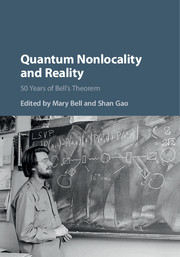Book contents
- Frontmatter
- Contents
- Contributors
- Preface
- Preface
- Part I John Stewart Bell: The Physicist
- Part II Bell's Theorem
- Part III Nonlocality: Illusion or Reality?
- Part IV Nonlocal Realistic Theories
- 19 Local Beables and the Foundations of Physics
- 20 John Bell's Varying Interpretations of Quantum Mechanics: Memories and Comments
- 21 Some Personal Reflections on Quantum Nonlocality and the Contributions of John Bell
- 22 Bell on Bohm
- 23 Interactions and Inequality
- 24 Gravitation and the Noise Needed in Objective Reduction Models
- 25 Towards an Objective Physics of Bell Nonlocality: Palatial Twistor Theory
- 26 Measurement and Macroscopicity: Overcoming Conceptual Imprecision in Quantum Measurement Theory
- Index
- References
19 - Local Beables and the Foundations of Physics
from Part IV - Nonlocal Realistic Theories
Published online by Cambridge University Press: 05 September 2016
- Frontmatter
- Contents
- Contributors
- Preface
- Preface
- Part I John Stewart Bell: The Physicist
- Part II Bell's Theorem
- Part III Nonlocality: Illusion or Reality?
- Part IV Nonlocal Realistic Theories
- 19 Local Beables and the Foundations of Physics
- 20 John Bell's Varying Interpretations of Quantum Mechanics: Memories and Comments
- 21 Some Personal Reflections on Quantum Nonlocality and the Contributions of John Bell
- 22 Bell on Bohm
- 23 Interactions and Inequality
- 24 Gravitation and the Noise Needed in Objective Reduction Models
- 25 Towards an Objective Physics of Bell Nonlocality: Palatial Twistor Theory
- 26 Measurement and Macroscopicity: Overcoming Conceptual Imprecision in Quantum Measurement Theory
- Index
- References
Summary
Introduction: The Theory of Local Beables
John Bell's most celebrated contribution to the foundations of physics is his famous theorem. The theorem demonstrates that any physical theory capable of generating the predictions of the standard quantum-mechanical algorithm, in particular the prediction of violations of Bell's inequality for experiments done at spacelike separation, cannot be local. The sense of “locality” used here is the same sense that Einstein had in mind when he pointed out that the standard interpretation of the quantum algorithm was committed to “spooky action at a distance” To this day, the import of Bell's theorem is not universally appreciated. I have written about this elsewhere [1], and others in this volume will take up that task. It is properly the main focus during this 50th anniversary of that great achievement.
But it is also important to recall and celebrate Bell's other achievements. In many of his later writings, including “The Theory of Local Beables,” “Quantum Mechanics for Cosmologists,” “On the Impossible Pilot Wave,” “Beables for Quantum Field Theory,” “Six Possible Worlds of Quantum Mechanics,” “Are There Quantum Jumps?” and “Against ‘Measurement,”’ 1 Bell turned his attention to the more general problem of physically construing the mathematical formalism used to derive these predictions. This activity is often denominated “interpreting quantum theory” as if there were some precise physical theory that might somehow be supplemented with an “interpretation” Once the issue is framed this way it is easy to ask: But if I already have a theory in hand, what can be gained by supplementing it with an “interpretation”? Many physicists, at this juncture, are happy to conclude that “interpretations” are not a matter of physics at all – maybe they are only of interest to philosophers – and that therefore the whole enterprise of “interpreting quantum theory” is not within the purview of physics per se.
What then is in the purviewof physics proper?One answer to this question goes under the banner “instrumentalism”: all physics as such, is concerned about is predicting the outcomes of experiments.
- Type
- Chapter
- Information
- Quantum Nonlocality and Reality50 Years of Bell's Theorem, pp. 317 - 330Publisher: Cambridge University PressPrint publication year: 2016
References
- 3
- Cited by



